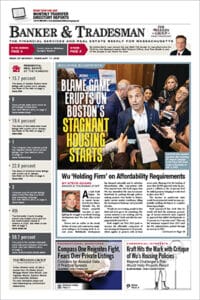
Newton’s leafy streets could become the next battleground in efforts to broaden access to homeownership for Greater Boston’s Black residents. A push is afoot to upzone parts of the mostly well-off city largely composed of single-family homes.
Greater Boston residents know the region’s housing has become increasingly unaffordable, even for middle-income families. With racial justice now front and center and the climate crisis un-ignorable, advocates in Newton are pushing for more diverse, denser housing to replace much of the region’s single-family stock as one way to help close the Black-white homeownership gap.
But not everyone’s on board, even in neighborhoods replete with Black Lives Matter signs – and experts say challenges exist to meeting the need with market-rate construction alone.
In Newton, the city’s natives and older adults planning to age in place are often priced out in a city where the year-to-date median single-family sale price hit $1.25 million in July according to The Warren Group, publisher of Banker & Tradesman.
“We need more multi-family units, more kinds of ways to let people into the market by providing a diverse housing stock with different price points,” said Jay Walter of Engine 6, a housing advocacy group in Newton.
While a draft proposal to change Newton’s overwhelmingly single-family zoning to something else has yet to coalesce and a vote is likely a year away, Walter imagines expanded multi-family zoning allowing large, sometimes historic, homes to become duplexes where residents grow old with newcomers living next door.
Zoning’s Original Sin
Greater Boston municipalities didn’t always prioritize single-family homes. Communities “built before the 1920s have more diverse housing options,” said public policy researcher and consultant Amy Dain, who has completed comprehensive studies on Boston housing; one in 2004 and another published last year.
Zoning based on dwelling type became typical in the U.S. in the 1920s, creating single-family neighborhoods that were unaffordable to lower-income people, notably Black would-be homeowners. The legacy remains: While 68.4 percent of Boston-area white households own their homes, 36 percent of local Black households do.
“Many of the zoning laws and regulations in our region came about as a way to keep households of color out of certain communities,” said Soni Gupta, The Boston Foundation’s director of neighborhoods and housing.
Even today, “the cities and towns of greater Boston are just highly restrictive of new development, really across the board,” Dain said.
Before George Floyd’s killing in May, many locals didn’t understand zoning’s history, said Gupta. That changed over the summer and now “there’s more outrage,” fueling desire to change local suburban housing stock,” she said.
The Housing Choice bill sponsored by Gov. Charlie Baker, currently under consideration in the state legislature, is poised to help channel that energy. It would make the vote required to approve most housing production-related zoning changes a simple majority, rather than the two-thirds vote currently required.
Assuming the bill passes, more communities could approve denser housing, providing “missing middle” housing stock: accessory dwelling units, multifamily units and cottage courts.
Fraught Debates
Efforts in Newton – and opposition to them – illustrate the slow, fraught nature of retooling.
Jeff Rhuda agrees that local zoning is overly restrictive, allowing little variety in the homes Symes Assoc., where he works as business development manager, builds. He sees another problem beyond bylaws.
“[Over the last 20 years] the entitlement process has gotten two to three times more expensive and more confrontational,” he said. “It’s why we’re producing half the housing today that we were producing in the early part of this century.”
Rhuda cited neighbor objections, particularly a rise in environmental concerns.
Steve McKenna, a broker and sales agent at Gibson Sotheby’s International Realty in Arlington, sees the same trend.
“[A municipality] needs to look at the land that they have, and utilize that for more affordable housing, but then that takes away from the open space,” he said. “So, then you have conservationists that don’t want to use a certain amount of open space to provide more housing.”

Consulting firm Cumming estimates detached, medium-quality single-family homes in the city of Boston currently cost between $281 and $386 per square foot to build, excluding land acquisition and permitting costs.
Construction Costs High
Affordability is another concern. Opponents of upzoning in Newton say even if the city goes through with the idea, new construction will be offered at pricey market rates. Advocates and industry figures agree that most newly-built homes will not be deeply affordable.
“The price of land is very expensive in Greater Boston, as is the price of construction. People talk about it like it’s the greedy developers,” said Dain, the housing researcher, but building unsubsidized housing at broadly affordable prices isn’t possible.
One way to alter this calculus, said Rhuda, is to add more units to a given parcel, spreading land and permitting costs among many condos.
“Again, they can subsidize things by changing density,” he said.
Nonetheless, construction industry data and consulting firm Cumming estimates detached, medium-quality single-family homes in the city of Boston currently cost between $281 and $386 per square foot to build, excluding land acquisition and permitting costs. Mid-rise multifamily construction costs even more in Boston: Between $392 and $510 per square foot, depending on height and type of construction used.
That could mean a middle-of-the-road condominium – the median new unit in a multifamily building built in the Northeast in 2019 was 1,268 square feet according the U.S. Census Bureau – whose construction costs alone are already at or above the median sale price of a condominium in Middlesex County, the priciest area of Greater Boston’s suburbs. That figure stood at $500,000 as of July 31, according to The Warren Group.
Still, by consistently producing housing at a certain price point, “you could impact availability and market at that affordability level and maybe one notch below it,” The Boston Foundation’s Gupta said.
It’s up to the public sector, she added, to make housing available to the area’s lowest-income households by creating affordable housing and subsidizing market-rate housing.
Will Change Come Quickly?
At the same time, psychological and emotional barriers to neighborhood change persist in Boston’s suburbs that could dampen hopes for widespread “missing middle” zoning changes.
“This is where tools, zoning, all that…comes up against this reckoning of ‘what is our community?’” said Katy Lacy, senior planner at the Massachusetts Housing Partnership.
Jesse Kanson-Benanav, a housing activist and senior project manager at B’nai B’rith Housing, noted the hypocrisy of neighborhoods with Black Lives Matter signs and pushback against
MHP Director of Research Tom Hopper said building diverse coalitions is key to addressing mental blocks around housing diversity.
“Having conversations around housing in communities before the proposal is on the table” with broad representation is a key step, he said.
As Newton’s zoning discussion continues, Gupta underscored the butterfly effect of land-use regulations: Stasis in suburban bylaws reverberates in less affluent communities as mounting housing costs. And while Black and brown Bay Staters might want to live in largely-minority communities where they feel understood, she said, Gupta offered an equity litmus test for Greater Boston: Can lower-income households that would choose to live in different communities do so?
“It’s really a matter of, ‘Are all the options available for a household that might want to exercise them?’” she said. “And they’re not.”





